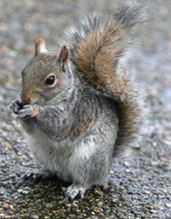The UK has long played a key role in human migrations, being one of the first nations to open the door to the Americas, Australia and countless other corners of the world. Our ability to help species settle and thrive across the world has not always worked in our favour though. Pest control in London is a big problem because there are so many different pests, many of which are invasive species that are difficult to control. These species are part of The Great Pest Migration that occurred alongside the migration of human populations. These days they are less exotic and more of a nuisance but they are not to be dismissed as cute, cuddly parts of nature. Pests are often harmful to our health and that is why it is important to understand them and how to control them. Take the grey squirrel for example, it originated on an entirely different continent but is now commonplace in the UK and has managed to completely displace our native red squirrel. Let’s take a closer look at this incredibly successful pest:
Name: The Grey Squirrel (Sciurus Carolinensis)
Appearance: Grey fur (sometimes with brown tones), white undersides and a distinctive bushy tail
Height/Weight: Bodies are generally 23-30cm long, tails are normally between 19-25cm long and they weigh between 400-600g on average
Characteristics: They don’t hibernate and they are most active in the early and late hours. As scatter–hoarders they hoard sizeable amounts of food in numerous sites for later recovery (each squirrel has several thousand hoards each season). The grey squirrel has great spatial memory, finding their hoards of food by remembering landmarks rather than relying on scents
Diet: They will eat a wide variety of food but often end up raiding bird feeders and scavenging from humans
Habitat: In the wild their nests are built with dried leaves and twigs in the forks of trees but in populated areas they build nests in attics and exterior walls
The grey squirrel is a tree squirrel native to North America. First recorded in the Carolinas, they originated in the eastern and Midwestern states as well as some eastern regions of Canada. They have since been introduced to other parts of the world including the UK, Italy, South Africa and Australia where they have thrived.
Arriving in the UK from North America in 1876, the grey squirrel was introduced to Woburn Abbey by the Duke of Bedford. From there the species spread rapidly around the country and almost entirely displaced the UK’s native red squirrel, becoming an invasive species in the wild and a pest to humans. Their numbers are so great and their pest status so critical that under the Wildlife and Countryside Act 1981, if you trap a grey squirrel in the UK it is illegal to let the creature back into the wild by release or escape; it must be destroyed humanely instead.
The grey squirrel is such an invasive species that is seen as a threat in the wild but it is also a great nuisance in areas populated by humans, both rural and urban. Not only do they cause damage to homes when they build their nests in attics and exterior walls, they also pose a fire hazard because they have a habit of gnawing through electrical wiring and cables. They are also a pest problem because of their tendency to scavenge for food in homes, gardens and public areas.
Not content with displacing the red squirrel, the grey squirrel is still embracing its status as an invasive species. Unfortunately, they are now causing problems for humans instead of other animals. It is because of their number, their threat to the natural landscape and the disturbance they cause in homes and businesses that they are one of the most serious pests from The Great Pest Migration.
So whilst the grey squirrel may seem like a cute, harmless animal as it scurries around the local park it is actually much more sinister, a threat to other wildlife and a pest to human populations.




Leave a Reply